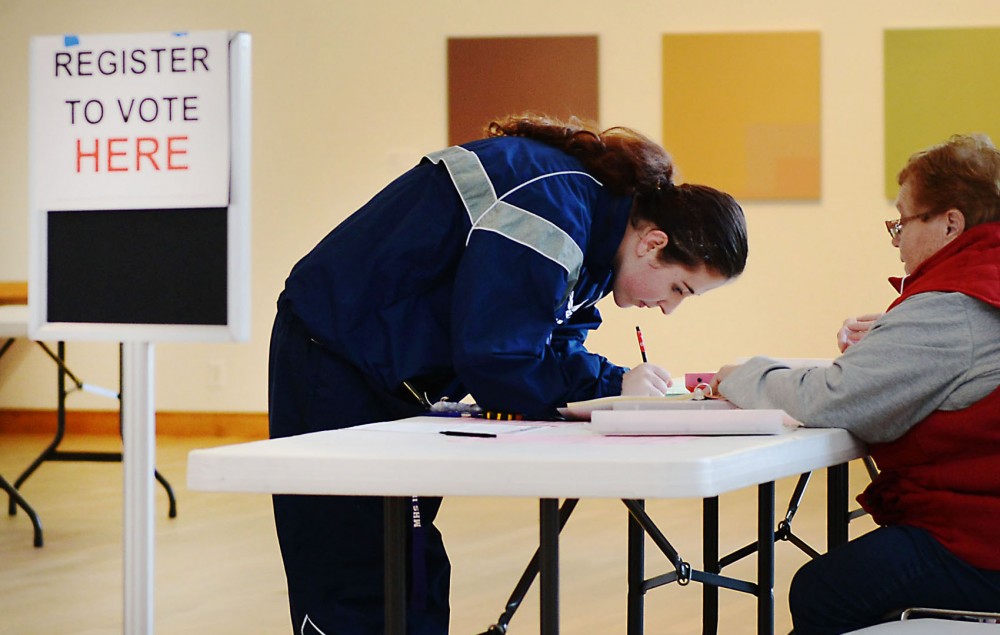Initial results from Tuesday’s Minneapolis municipal election show only about a quarter of voters in student-heavy wards showed up to the polls to vote for a new mayor, City Council members and other local offices.
In the 2012 election, students rallied around two controversial amendments and a presidential election, pushing the turnout for wards 2 and 3 both above 80 percent.
Those wards contain the University of Minnesota, Marcy-Holmes, Dinkytown, Southeast Como, Cedar-Riverside and Prospect Park.
This year, Ward 2 had the third-lowest turnout of 13 wards, and Ward 3 had the fifth-lowest. Both fell below the approximate citywide rate of 34 percent.
After voting at the University Lutheran Church of Hope, third-ward resident Jim Erickson said he expected turnout to be even lower than what he saw.
“We’re not voting for major offices like president,” he said.
Political science associate professor Kathryn Pearson said municipal elections have low turnout, even when the races are competitive.
“A lot of voters probably are thinking, ‘Well, I just voted in a presidential election a year ago. How can it already be election time?’” she said.
Sid Teske, an election judge at the Van Cleve Recreation Center polling place, said he saw a turnout consistent with past city elections.
Teske said students don’t often vote in city elections because they only live in the city for a few years. Local officials won’t affect them the same way federal officeholders do, he said.
Only one-fifth of registered voters turned out to cast ballots for Minneapolis’ last municipal election in 2009. That year, wards 2 and 3 tied with Ward 6 for the lowest turnout when they reported less than one in seven registered voters had cast a ballot.
Before this year’s election, Minneapolis City Council member and Council Elections committee chair Cam Gordon said he would be “really happy” if turnout reached 50 percent.
Only Ward 13 came close to that goal, with a turnout of around 43 percent. Ward 13 is represented by Councilwoman Betsy Hodges, who is poised to win the mayoral election.
Gordon also said he expected student turnout to be higher than it was in 2009.
“I think because there is a contested mayoral race and people are running really hard to campaign … that will get more people out to vote, and they’ll be more interested,” he said before this year’s election.
Pearson said Minneapolis’ ranked-choice voting system may have affected the turnout by contributing to the wide field of mayoral candidates.
“Voters incurred more costs, learning about more candidates,” Pearson said, “but on the other hand, voters may have also felt more benefits because they could cast a vote for the candidate that they like the most and then cast another vote strategically.”
The voting system’s effect on turnout is uncertain, Pearson said.
Environmental sciences, policy and management senior and Minnesota Public Interest Research Group co-chair Cora Ellenson-Myers said MPIRG’s campaign to encourage voting this year was the largest it had ever done for a municipal election.
She said MPIRG expected higher voter turnout than 2009 because the group used the same tactics as it did during the 2012 election season.
Student turnout shifts on a larger scale between municipal and federal elections, Pearson said, because students are “are less habitual voters.”
MPIRG reported meeting with more than 1,500 residents of Dinkytown, Marcy-Holmes and Como in the weeks leading up to Nov. 5. Even with these efforts, some students said they felt uninformed.
Ellie Chenoweth and Whitney Wasko, University freshmen, both said they did not vote in City Council elections for that reason.
“I didn’t know much about that,” Wasko said.
Kia Farhang, Alma Pronove and Tyler Gieseke contributed
to this report.
*Turnout numbers based on 2012 numbers of registered voters (2013 numbers are not available yet).







